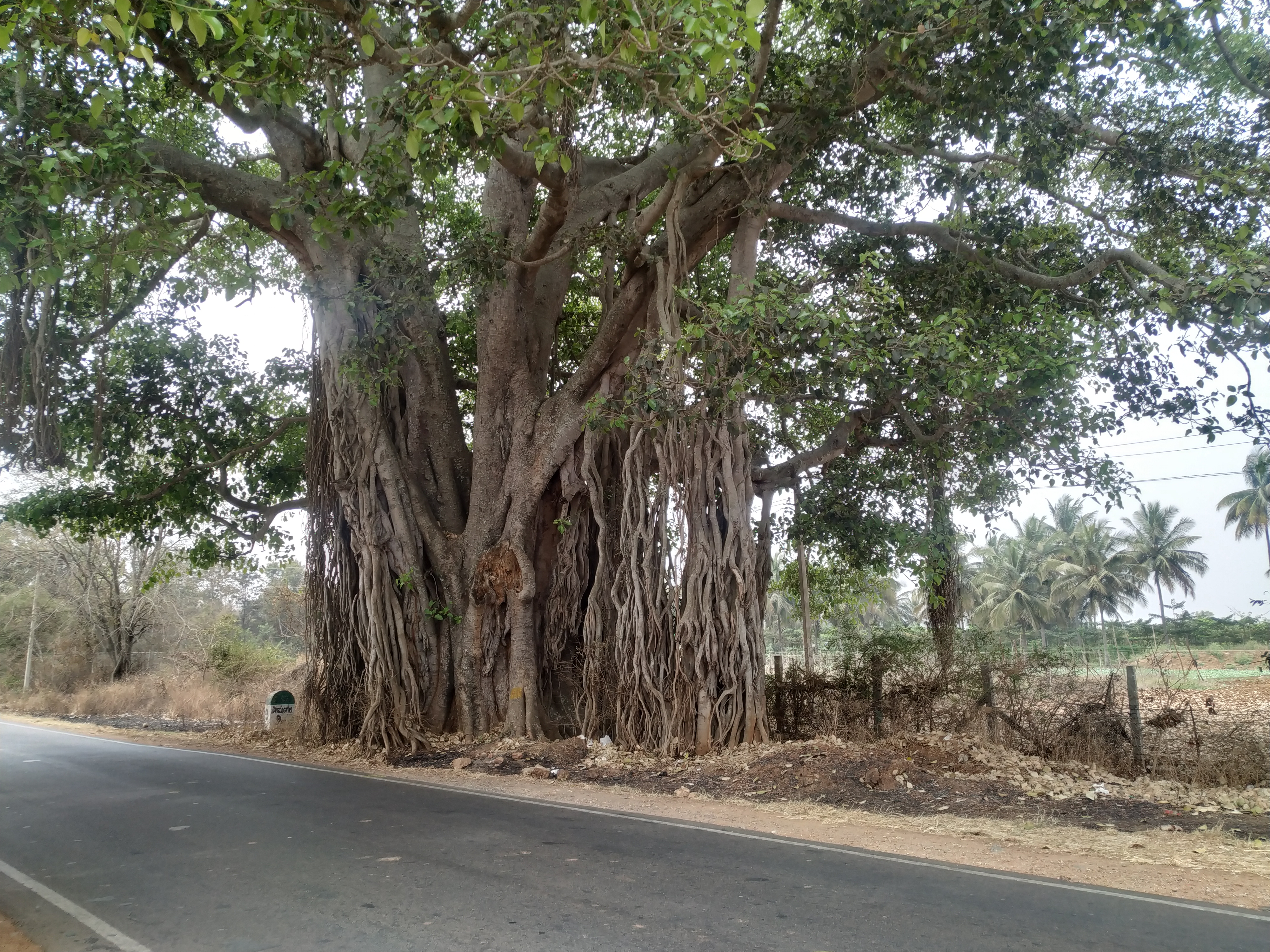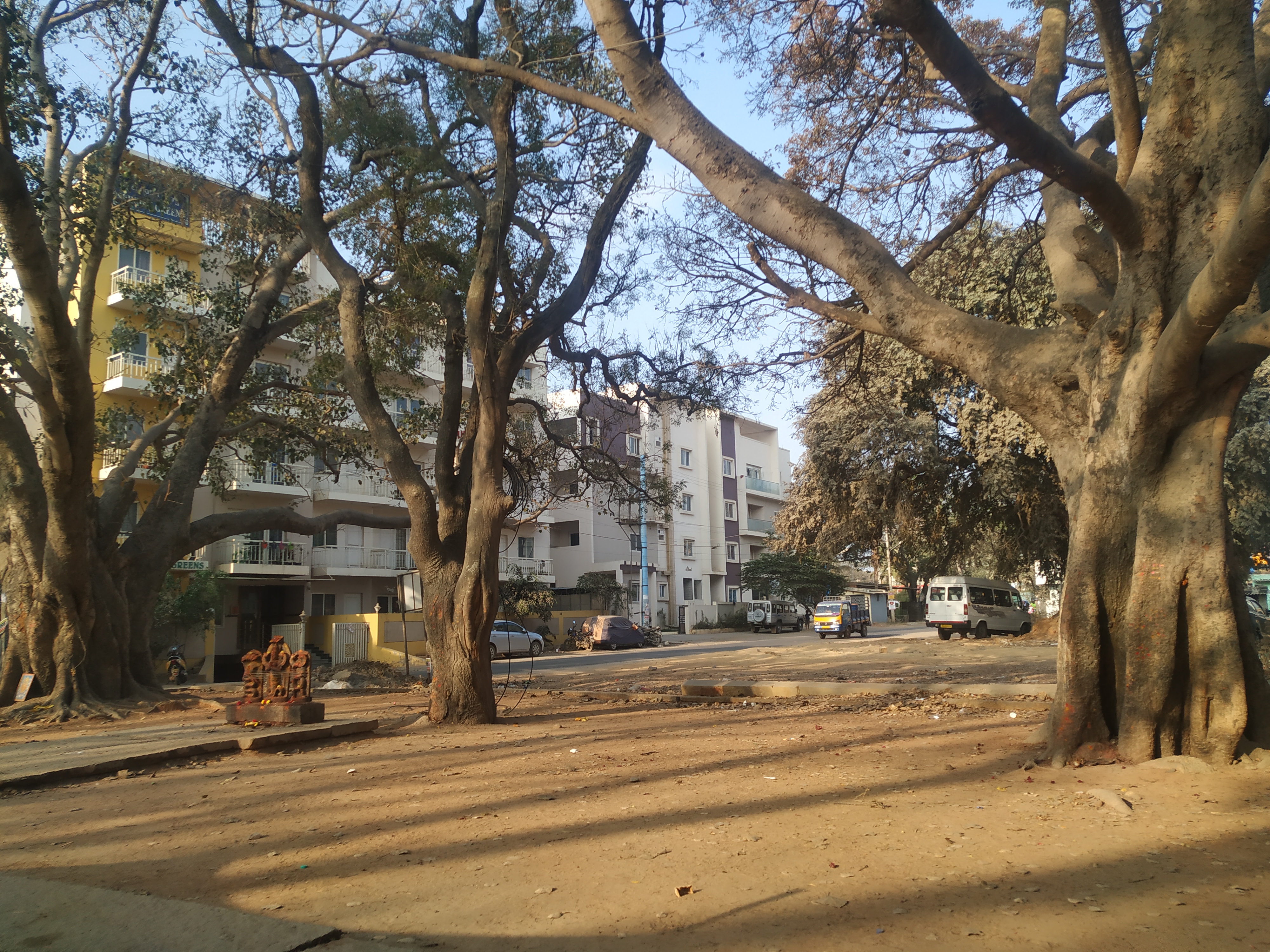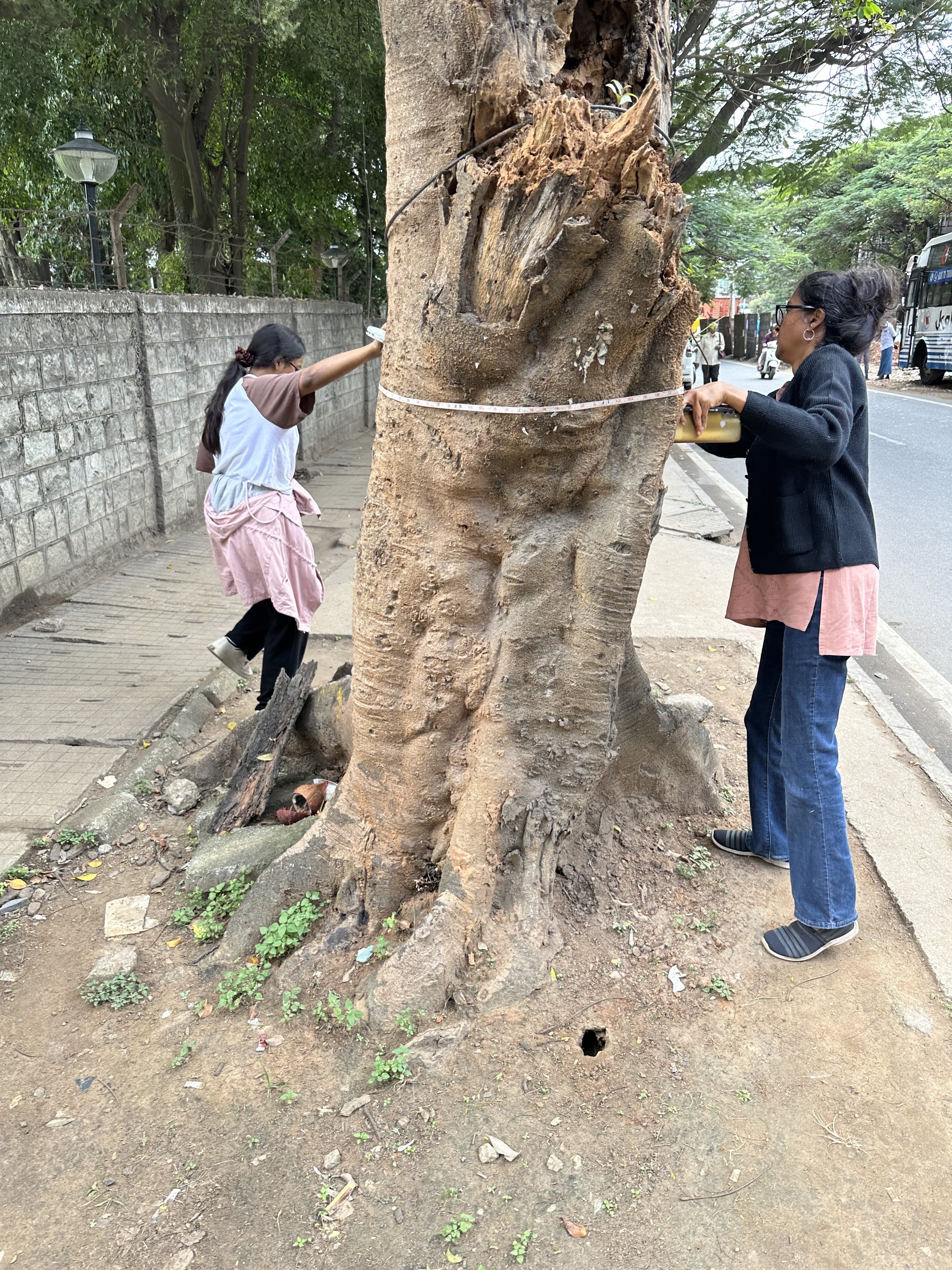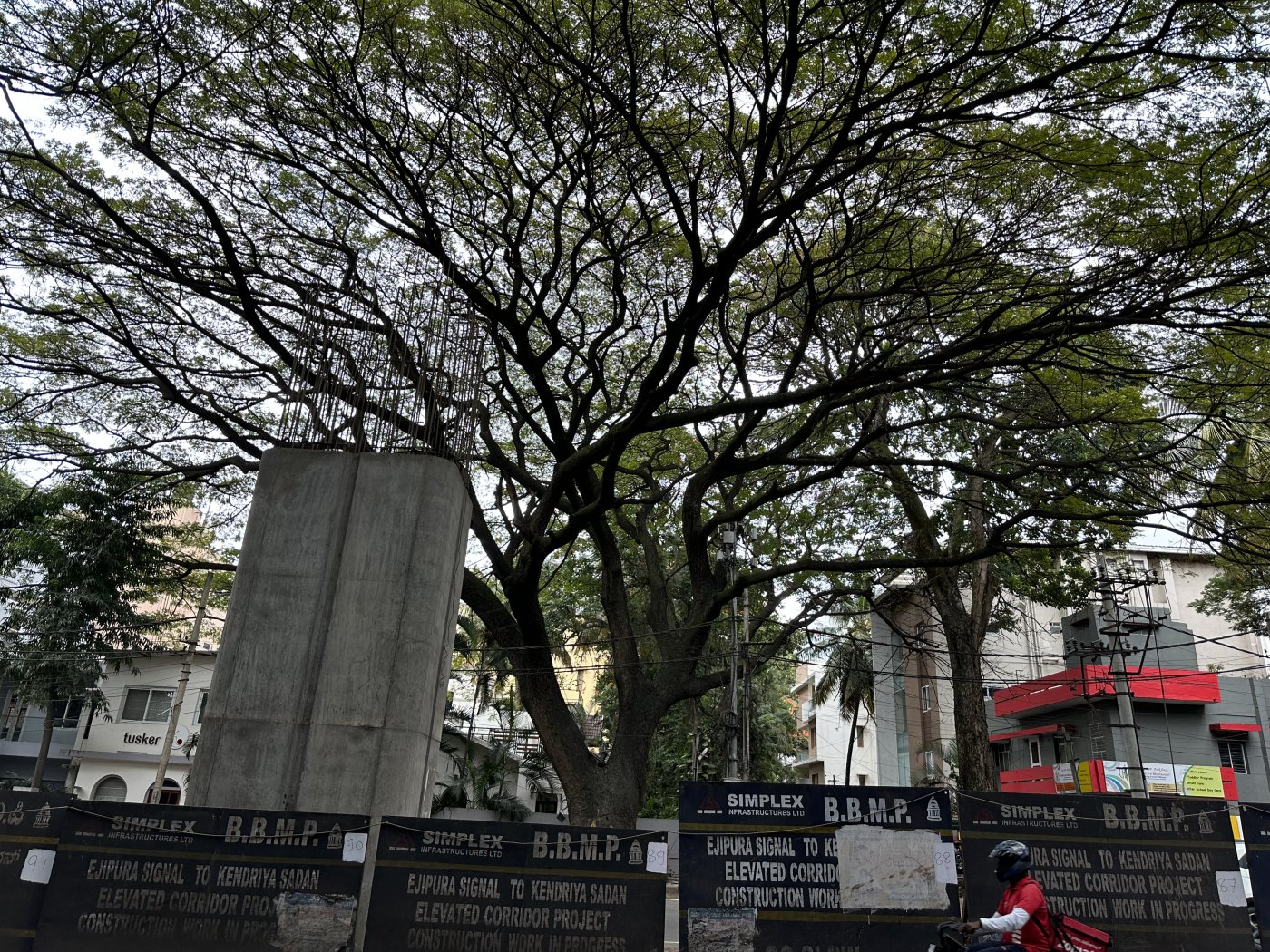Bengaluru: “Never doubt that a small group of thoughtful, committed, citizens can change the world. Indeed, it is the only thing that ever has.”
This quote by the well-known cultural anthropologist Margaret Mead has never been truer than in the recent victory of a citizens group who fought, and won, the battle to protect a stretch of magnificent banyan trees along a national highway in India.
A 46-km stretch of road between Hyderabad and Manneguda had been marked by the government of Telangana for widening into a four-lane highway. Once a part of the state highway (SH-4) this road was transferred to the National Highways Authority of India (NHAI) in 2017 and renamed as National Highway 163 (NH-163).
Like several other road widening projects in the country this too would have resulted in the loss of thousands of trees. The number of trees aside, what alarmed many was that the 900 banyan trees were huge in size and possibly more than 100 years old, lining the road in Chevella, as Article 14 reported in November 2024.
The Chevella banyans, as they are popularly known, held fond memories for several people who were horrified that the banyans would be lost forever. Galvanised to do something, a group calling themselves Nature Lovers of Hyderabad started the campaign “Save the Banyans of Chevella” with an online petition in 2019.
Campaigns like this come at a time of unprecedented global warming. The years 2015 to 2023 were the nine warmest years on record, with global temperatures reaching at least 1 deg C above the 1850-1900 pre-industrial baseline, according to the World Meteorological Organization, which said in a statement that 2023 had “shattered climate records, accompanied by extreme weather which has left a trail of devastation and despair”.
India has repeatedly been shown as one of the countries most vulnerable to global climate-change risks (here, here and here). Within these overall perils, there are specific threats to urban India.
On a high carbon pathway, which India is on currently, climate science models show that temperatures in the country could exceed 1.8 deg C, according to a G20 Risk Atlas, released by the Fondazione Centro Euro-Mediterraneo sui Cambiamenti Climatici, a global nonprofit and think tank. The Atlas, compiled by scientists, economists and technicians, said cities in India faced “many threats from climate change”.
“Unless we take urgent action, increasing extreme weather will batter urban communities across the country—damaging crucial infrastructure and causing massive economic losses,” said the Atlas. “Increasing heatwaves and worsening air quality will harm urban residents’ health and even cost many their lives.”
With tens of thousands of trees already cut and many thousands more likely to be chopped, as governments clear such removal, often bypassing basic legal safeguards, hope to stem the tide comes mainly from citizens, such as those involved in the Chevella and other campaigns that we are familiar with.

Citizen Power
The Chevella campaign used multiple strategies to raise awareness about the banyans. Along with an online petition that garnered more than 60,000 signatures, members of the Nature Lovers Hyderabad met government officials, organised events to bring people to the banyans to raise awareness, held protests, and used print, digital and social media to spread the message on the need to protect these heritage trees.
They conducted a geo-tagging exercise, marking each of the banyans and collecting girth, height and biodiversity data for these keystone species. They recorded 914 banyans, many more than the 700 that the project said were on the stretch of road.
A petition was also filed in the National Green Tribunal (NGT) in December 2021 against the felling of the banyans. In every sense, this has rightly been described as a David versus Goliath battle, with powerful government authorities obfuscating the truth, bending or breaking the laws and citizens winning a rare battle.
The members of this group were ordinary citizens pursuing different professions. They had no experience with media, courts and protests, but their love for nature and shared memories of these banyans brought them together.
On 6 November 2023, the NGT ruled in favor of the petitioners from the Nature Lovers Hyderabad, directing that the NHAI conduct an environmental impact assessment to minimise the loss of trees before going ahead with the project.
“Two simple words-We won” on the campaign’s website reflected the jubilation of the group. The battle to save the Chevella banyans had been won—for now.
At the end of the day, it was undeniable that it was the sustained effort of a seemingly ragtag group of people who had come together with the determination to protect the trees that paid off. By doing so they gave hope to others waging similar battles to protect urban trees across cities and towns in India.
Development Vs Environment: Trees As Victims
India is one of the world’s hotspots of urbanisation.
In 2018 only 34% of the population of the country was urban. But projections in the World Urbanization Prospects indicate that by 2050, India will add 416 million to its urban population—doubling the urban population of the country in 32 years.
Touted as engines of growth, cities are said to be critical for a country like India, as they contribute 60% of the country’s gross domestic product (GDP).
But global concerns of securing a sustainable urban future owing to environmental and climate change challenges are pressing issues for Indian cities too.
Every winter, the capital city of New Delhi gasps because of high levels of air pollution. Once known as the Garden City, Bengaluru has recently witnessed erratic weather patterns that include sudden downpours and searing temperatures. Chennai witnessed another devastating flood in December 2023 after the last one in 2015.
While these and the many other environmental challenges of cities across India are natural or human-made, exacerbating the impacts is the way the resilience of cities and its residents has been compromised by urban planning, which pits development and environment against each other.
Across India’s cities and towns, the development-versus-environment conflict is regularly visible in urban infrastructure projects that lead to the felling of trees.
Trees in cities are usually the first victims of urban infrastructure projects: road widening, flyovers, or metro lines. Trees that have taken decades to grow are chopped down overnight often without any impact assessment or opportunity for the public to express their concerns (here, here. here and here).
Tree lovers are branded anti-development, and projects can pit one group against another in cities.
In the case of the construction of a steel flyover in Bengaluru, the city was split into the #SteelFlyoverBeku and the #SteelFlyoverBeda groups—the former opposing the project because of the trees that would be lost and the latter in favour of the project, arguing they faced the brunt of the traffic congestion on the road where the flyover was proposed.
But are trees really that important for cities? And isn’t the loss of trees justified if it means it will help improve mobility and infrastructure of cities?
Why Do We Need Trees In Our Cities?
Every Indian city has a unique history—of its origin and growth over years. Entwined with the history of the city, and often ignored, is how nature has played a critical role in shaping these cities of today. Trees in cities have been no exception.
Trees, as silent sentinels have witnessed history unfolding around them or have themselves created history—whether it is the banyan in Homi Bhabha Circle in metropolitan Mumbai under which the Bombay Stock Exchange was initially set up or the peepul located in Ghanta Ghar junction of the hill town of Dehra Dun planted by Sarojini Naidu.
There are similar trees yet to be documented across our cities and towns that qualify as heritage trees because of their historical significance. This to many tree lovers is reason enough for protecting the trees.
Many urban trees are also protected because they are sacred or have cultural significance. In Bengaluru ashwathkattes—raised platforms with a neem tree in the centre usually flanked by peepul trees with snake shrines or local deities at the base—can be found along roads across the city.
Even on the busiest of roads we can see the ashwathkattes and hear the characteristic rustle of peepul leaves above the noise of the traffic. While the sacredness of these kattes may not always protect them from being removed for any mobility related projects, the likelihood that they will be retained in some form is much higher.
This sacredness and cultural significance of trees was also acknowledged in the NGT ruling of the Chevella banyans that begins with a Tamil verse by the 16th century Pandian ruler Ativirarama’s poem about the banyan tree.
If history and culture are not enough reasons to protect trees, then the biggest reason for us to protect urban trees in cities is because of how critical they are for our very survival.
Climate change, air pollution and biodiversity loss are the triple planetary crises that we are faced with today. Cities contribute to all three, and it is trees in cities that can help mitigate the impacts from the planetary crisis we are in.
Forests across the world are carbon sinks and play a critical role in mitigating climate change. And while trees in cities may not compare to a rainforest in terms of the quantity of carbon they sequester, the carbon urban trees can remove is not insignificant.
In an environmental impact assessment conducted in January 2023 to understand the impacts of a flyover project in Bengaluru we found that 121 metric tonnes of carbon were sequestered by 55 trees in a 600 m stretch of the road. A single banyan tree with a girth of 600 cm and height of 10 m in this stretch would sequester about 6 tonnes of carbon.
According to the Environmental Protection Agency, USA, a typical passenger vehicle emits around 4.6 tonnes of carbon every year. The girth, height and species of trees all determine the amount of carbon that can be absorbed by a tree.
Thus, careful selection, preservation and planned planting can help reduce the carbon emissions that contribute to climate change.

Keeping Temperatures Down
Another constant refrain we hear today is the rising temperatures in Indian cities.
The urban heat-island effect, where a city records much higher temperatures than the surrounding areas owing to urbanisation related land-use changes, has serious impacts on health and livelihoods of urban residents.
Heat can be debilitating, even life threatening. This is especially so for those whose livelihoods in cities require them to work in the hot sun for long hours such as construction labour, sanitation workers and street vendors.
These daily wage earners have no options—if they do not work, they do not eat. Kerala was gripped by a heatwave in 2023 and in addition to releasing an advisory instructing people to take precautions, the government also directed that working hours especially of those who must work in the sun, be changed from 7 am to 7 pm to accommodate a break in work between 12 pm to 3 pm.
But this is not an option for many whose work requires them to be out even during these hours such as gig workers. It is predicted that if temperatures continue to rise there will be a loss in daylight working hours that not only impacts the daily wage earners but also the economy of the country as a whole.
With & Without Trees
Trees have an important role to play in maintaining micro-climate and mitigating the impacts of the urban-heat-island effect.
Our research in 2013 in Bengaluru compared stretches of roads with and without trees. We found that road stretches lined with trees had much lower surface and ambient air temperature. The difference in road surface temperature was especially significant—lower by 27.5 deg C in one illustrative segment of a road with trees.
The highest road surface temperature recorded in a segment of road without trees was around 55 deg C, while a segment nearby with trees was much lower at around 33 deg C. Walking on a road without trees is like stepping on a frying pan.
The rising levels of air pollution in Indian cities is a cause for concern especially when it comes to the health of children, and elderly. According to the World Air Quality Report 2022, 12 of the 15 most polluted cities are in India.
The components of air pollution include suspended particulate matter (SPM) as well as toxic gases from vehicular traffic, industries, and construction work in cities.
When it comes to mitigating air pollution trees once again play an important role. Trees do this by absorbing polluting gases such as carbon monoxide, carbon dioxide, sulphur dioxide and nitrogen dioxide.
Trees also settle dust and reduce the quantity of SPM in the air that we otherwise breathe.
Our research on roads with and without trees in Bengaluru showed that on average roads with trees had SPM in significantly lower levels when compared to segments without trees, around 150 µg/m3 (micro grams) with trees compared to 300 µg/m3 without trees.
The Biodiversity Of Cities
Cities, we may assume, are unlikely places when it comes to harbouring biodiversity. There are many cities across the world located adjacent to urban protected areas and Indian cities are no exception.
New Delhi the capital city has the biodiversity rich Delhi Ridge that is part of the ancient Aravali mountain range. Bengaluru has Bannerghatta National Park at its southern periphery which even has charismatic species such as elephants and tigers.
Mumbai and Chennai, both have national parks in the centre of the city. Chennai’s Guindy National Park is home to the endangered blackbuck and Mumbai’s Sanjay Gandhi National Park has a population of leopards.
In Bengaluru city’s core area, we can still find the slender loris, a nocturnal primate species, which uses the tree canopy for nesting, feeding, and movement. Road widening and flyover projects in the city that are fragmenting the green cover are impacting the survival of the slender loris. A single tree such as the banyan is an ecosystem by itself. The loss of keystone species like the banyan that are a a habitat for insects, birds and mammals is therefore even more concerning.
The Damage From One Road
But development projects are impacting the tree cover in these protected areas, whether it is the metro work in Mumbai or, as another of the impact assessments we conducted in 2020 showed, in a 152-km peripheral ring road in Bengaluru that will cut through the Anekal Reserve Forest contiguous to the Bannerghatta National Park.
For instance, in one 33.2-km stretch, media reporting suggested that 184 trees were to be cut. From our field assessment, we counted around 1,000 trees already marked to be cut, in addition to several unmarked trees but also likely to be cut during the road widening.
We recorded on these stretches several heritage trees, the loss of which will be irreplaceable, such as a 50-ft tall banyan, others with girths from 10 m to nearly 18 m. Other large heritage tree species, most already cut, included peepul, Mysore fig, raintree, neem, teak, tamarind, and jamun.
We recorded 15 sacred ashwathkattes marked for removal. Three especially large peepul trees marked for removal on the ashwathkattes had girths of 5.8 m, 4.3 m and 3.5 m.
Along the six stretches of roads that we sampled, we recorded 14 lakes. This includes Varthur, the second largest lake in Bengaluru, and the 568-acre Madure kere. The road widening project will severely affect groundwater recharge, flood control and biodiversity in these lakes and impact livelihoods of local grazers and fisherfolk who use these lakes.
Chipko Movements In The City
That urban greenery is worth protecting for its historical, cultural, and ecological benefits is now understood by many passionate urban residents. They are the ones who are galvanised into action whenever trees in cities are in danger of being axed.
Campaigns to save trees can be long drawn, emotionally and financially exhausting, requiring continuous strategising. What works in one campaign may not work in the case of another, and context specific strategies are required.
But there are some elements that remain critical irrespective of the context.
Online petitions help raise awareness among a wider population, even those in faraway places, but at the end of the day it is the people on the ground who can make the most difference.
In the case of the Save Chevella Banyans campaign it was the dogged determination of the motley group who inspite of their regular work and responsibilities at home took the time to organise protests, hold awareness events, and engage with different groups of stakeholders such the media, officials and the courts.
In Bengaluru, it was a human chain of more than 2,000 citizens from young children to senior citizens as part of the #SteelFlyoverBeda campaign and the coming together of several resident welfare associations in the case of the Sankey Tank flyover in Bengaluru that raised awareness about the ecological impacts of both projects.
Even police cases filed against residents in the case of the Sankey Tank flyover, that included children, did not stop the group from going ahead with their campaigns. In March 2023, the project was put on hold.

The Power Of Documentation
Another important aspect is the detailed documentation of the environmental impacts which was used in both the #SteelFlyoverBeda and the campaign against the Sankey Tank flyover.
Citizens groups in both instances reached out to ecologists in the city to collect ecological data to make their case stronger against the cutting of trees.
For example, in the case of the steel flyover and road-widening project, while the government claimed that only 1,668 trees would be lost, a detailed environmental impact assessment showed that 2,244 trees and 200 more saplings would be impacted and a large number of species would be lost.
The data collected of tree species, height and girth on the ground was used to calculate the carbon sequestered by the trees. The assessment also went beyond looking merely at trees, but also focusing on wider environmental impacts of the project on other ecosystems such as lakes in the vicinity.
Mumbai Vs Bengaluru
Another campaign that was in the news was against felling of around 2,700 trees for a metro shed in the Aarey colony located towards the south of Sanjay Gandhi National Park in Mumbai.
The Aarey forest is ecologically rich, even having a population of leopards. The fate of the forest is today still being decided in the courts with some tree felling allowed by the Supreme Court in the interim.
Many citizens of Mumbai did come together as part of the Save Aarey campaign to protest the greenery that would be lost: 33 hectares of forest with more than 2000 trees. This was itself thought to be surprising in a city that is said to not have a culture of protests especially those focused on environmental issues.
What had perhaps touched a chord about Aarey was that it was a forest, and the work done by local NGOs over the years to raise awareness on the importance of this green lung especially in the aftermath of flooding incidents that Mumbai was witnessing.
Today, along with the decision to go ahead with the metro car shed in the Aarey forest, there are also plans to promote Aarey focusing on tourism.
It is surprising that a city such as Mumbai sees fewer citizen groups coming forward to give their time and energy towards protecting trees or other urban ecosystems in peril.
In contrast Bengaluru has many vibrant citizen groups who have also over the years learnt how to come together, differences notwithstanding, strategize, use data and science along with media and the courts to protect urban tree cover.
Only One Option For Our Cities
The triple planetary crises of pollution, climate change and biodiversity collapse that we mentioned may well be upon us, but when it comes to urban greenery as a mitigating force there is much we can do.
We need to rewrite the narrative that trees in cities and development cannot co-exist. The slogan for the Save Chevella Banyans had been “Road bhi. Jhaad bhi”. At present projects are put forth and approved, after which tree cutting is presented as a fait accompli. This goes against the rule and spirit of the law and needs to change.
Details of a project must be made public when it is conceived, so those affected they can raise concerns and even offer suggestions.
In the case of the Chevella banyans, the citizens group wanted the NHAI to reconsider the alignment of the road such that the banyans would not have to be cut. At the least, transparency in sharing information can go a long way in building trust between citizens and officials.
Sometimes the choice may indeed be between cutting the trees and building a flyover. At such times it would be good to remember that a sleek flyover is of little use if the air we breathe is poison.
Any infrastructure projects in cities must thus start with the precautionary principle—that all trees must be saved. This will undoubtedly require a major change in the way urban planners and decision-makers think about development in cities.
The alternatives normally offered for trees that will be cut because of any project are afforestation or translocation. Translocation is costly, and as the NGT ruling in the Chevella case pointed out, is also not possible for trees with large girths.
Planting saplings in place of trees cut also has many limitations. No sapling can replace the ecological benefits provided by a mature tree that has taken decades to grow. The places where the saplings are planted are usually far away from where the trees have been cut.
What use is a sapling planted in a park in the city or on the city’s outskirts compared to a tree that provided shade, sequestered carbon, and reduced air pollution along the road where it originally stood?
The battle to save the Chevella banyans may have been won, but the war to protect the tree cover in cities rages on. While we celebrate the judgement, much remains to be done to save the fast diminishing green cover of our cities.
At the same time, given the severity of the climate catastrophe looming over our heads, we need to ensure that trees are protected and planted across India’s cities, valued as important aspects of green infrastructure that can help India’s urban residents adapt to and live with the ill effects of climate and environmental change, including heat waves, floods, droughts, sea level rise, air pollution and other challenges.
Trees and urban nature need to be integrated into city planning and developmental visions, instead of being occasionally tagged on as afterthoughts—as is now the case.
(Seema Mundoli is on the faculty of Azim Premji University, where her research focuses on urban sustainability. Harini Nagendra is on the faculty of Azim Premji University and leads the Centre for Climate Change and Sustainability.)
Get exclusive access to new databases, expert analyses, weekly newsletters, book excerpts and new ideas on democracy, law and society in India. Subscribe to Article 14.

